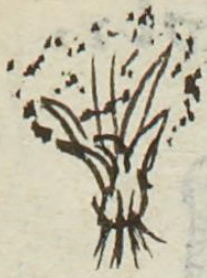Cecualoc (MH671r)
This black-line drawing of the simplex glyph for the personal name Cecualo (“Frozen”) is attested here as a man’s name. The glyph shows a frontal view of a plant, perhaps zacatl (grass, weeds, hay) with visible roots. Surrounding the plant, at the top of the blades or leaves, are many dots, perhaps meant to suggest ice or frost and point to the verb cecualo, to become frozen. This verb is given in the preterit (-c ending).
Stephanie Wood
This is the first glyph in the collection to refer to a freeze, seemingly an agricultural freeze. See below, however, for an iconographic sample of what may be a freeze, a frost, or a snowfall (perhaps tequizqui or cepayahuitl). It has glyphic elements, but the gloss says “nieves” (ices, in Spanish). A glyphic rendition of tequizqui appears in the Codex Mendoza, also appearing below).
Stephanie Wood
1560
Jeff Haskett-Wood
helar, plantas, agricultura, verbos, pretérito, nombres de hombres

cecualo, to become frozen, https://nahuatl.wired-humanities.org/content/cecualo
Helado
Stephanie Wood
Matrícula de Huexotzinco, folio 671r, World Digital Library, https://www.loc.gov/resource/gdcwdl.wdl_15282/?sp=422&st=image.
This manuscript is hosted by the Library of Congress and the World Digital Library; used here with the Creative Commons, “Attribution-NonCommercial-ShareAlike 3.0 License” (CC-BY-NC-SAq 3.0).



